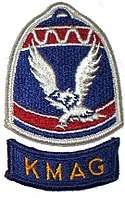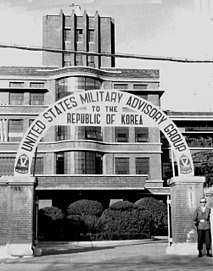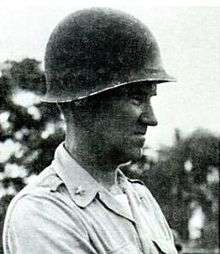Korean Military Advisory Group
The Korean Military Advisory Group (KMAG) (officially United States Military Advisory Group to the Republic of Korea) was a United States military unit of the Korean War. It helped to train and provide logistic support for the Republic of Korea Army.
| Korean Military Advisory Group | |
|---|---|
 Shoulder Sleeve Insignia for KMAG | |
| Active | est. 15 August 1948 |
| Country | United States |
| Commanders | |
| Notable commanders | Francis W. Farrell Cornelius E. Ryan Gordon B. Rogers |
| Insignia | |
| KMAG | KMAG Insignia |
History
Following the end of World War II, the United States and the Soviet union split up the administration of Korea, with the United States taking charge of the southern half. Beginning in January 1946, the U.S. military government in the south began to form a Korean defense force,[1] and 18 lieutenants from the U.S. Army's 40th Infantry Division were tasked with organizing eight Korea Constabulary Regiments (one for each province,[2]), which were to act as a police force.[3] The Constabulary grew rapidly, from 2,000 men in April 1946[2] to 50,000 in March 1948.[3] When the ROK declared independence on 15 August 1948, the Constabulary was absorbed into the Republic of Korea Army,[2] and the United States created a Provisional Military Advisory Group (PMAG) to continue the work of training and advising the fledgling South Korean military,[4] led by Brigadier General William Lynn Roberts (USMA 1913). The 100 American advisors in Korea,[5] working under the auspices of the Department of Internal Security (DIS), were reassigned to PMAG at this time, and the unit's roster was expanded.[6]

On July 1, 1949, PMAG was redesignated the United States Military Advisory Group to the Republic of Korea (KMAG).
When North Korean forces invaded South Korea on June 25, 1950, KMAG became the United States Military Advisory Group, Korea, 8668th Army Unit, under the command of the United States Eighth Army. Brigadier General Francis W. Farrell (USMA 1920) took command of the unit on July 25 and had to face high rejection rate within South Korean draftees, when after a month, the Replacement Training Center had rejected 10,000 recruits as medically or physically unfit. On 28 December 1950, it was renamed as the 8202nd Army Unit.[7][8][4]
KMAG had also short supplies of were tents, radios, ambulances, clothing, food and water, fuel, sandbags, wood planking, compasses, rifle cleaning kits, medical supplies, and above all, ammunition. Farrell also fought with the lack of qualified instructors. New Commanding general of Eighth Army, James Van Fleet, was not fully satisfied with the progress of KMAG and although he thought Farrell had done a wonderful job as KMAG chief, he felt that Farrell was “completely worn out and needed a change.”[7][8]

Van Fleet requested highly qualified troop trainer, Brigadier general Cornelius E. Ryan, a former commander of 101st Airborne Division, whom he knew from his previous assignment in the United States. Ryan assumed command on July 7, 1951 with the task was to transform the Republic of Korea Army (ROKA) into a fighting force capable of carrying its weight in United States Eighth Army and make Korean Military Advisory Group responsive to the needs of the Republic of Korea Army.[7][8]
He developed strong relation with his counterparts, generals Lee Chong-chan and Paik Sun-yup and worked together on plans to make a new army. When Ryan arrived in Korea, KMAG had 920 officers and men assigned to it and by September 1951, Ryan supervised 1,308 advisors. He later increased the number of KMAG advisors to the total strength of 1,812 personnel by January 1952. Altogether, 499,751 trainees passed through the KMAG Replacement Training Center system from July 1950 through August 1953.[7][8]
Under his leadership, KMAG transformed into a first-class military training and advisory mission. Under his experienced direction, KMAG then inaugurated a series of training and organizational reforms that laid the basis for a Korean Army capable of fighting the Chinese on more equal terms. Ryan served in Korea until mid-May 1953, when he was succeeded by Brigadier general Gordon B. Rogers.[7][8]
Command Structure
Chiefs of the KMAG
- BG William L. Roberts (July 1, 1949 – July 25, 1950)
- BG Francis W. Farrell (July 25, 1950 - July 7, 1951)
- MG Cornelius E. Ryan (July 7, 1951 - May 14, 1953)
- BG Gordon B. Rogers (May 14, 1953 - October 1953)
Deputy Chiefs
- BG Arthur S. Champeny (July 1951 - 1953)
Legacy
Dr. Shiela Miyoshi Jager of the Strategic Studies Institute has supported using the highly successful KMAG methods as a model for the Multi-National Security Transition Command - Iraq in its development of the New Iraqi Army.[9]
Notes
- "ROK Army History". Global Security. Retrieved 3 December 2010.
- Yuk Gun. "South Korean Army". korean-war.com. Retrieved 3 December 2010.
- Summers, pg. 161
- Advising Indigenous Forces: American Advisors in Korea, Vietnam, and El Salvador, by Robert D. Ramsey III, Combat Studies Institute Press, Fort Leavenworth, Kansas, 2006, page 21
- Sawyer, p. 35
- Stoker, p. 88
- "FIGHTING IN A KOREAN WAR: THE AMERICAN ADVISORY MISSIONS FROM 1946-1953 by Bryan Robert Gibby, B.S., M.A." etd.ohiolink.edu. The Ohio State University. Retrieved 1 June 2004.
- "The Korean Military Advisory Group (KMAG): A Model for Success?" (PDF). apps.dtic.mil. Defense Technical Information Center Websites. Retrieved 1 June 2004.
- Dr. Shiela Miyoshi Jager. "Iraq Security Forces and Lessons from Korea" (PDF). Strategic Studies Institute. Retrieved 10 November 2009.
References
- Sawyer, Robert K. (1963). Military Advisors in Korea: KMAG in Peace and War (PDF). U.S. Department of the Army Office of Military History.
- Stoker, Donald J. (2008). Military Advising and Assistance: From Mercenaries to Privatization, 1815-2007. Psychology Press. ISBN 0-415-77015-7. Retrieved 3 December 2010.
- Summers, Harry G. Jr. (1999). Korean War Alamanac. Replica Books. pp. 160–162. ISBN 978-0-7351-0209-5.